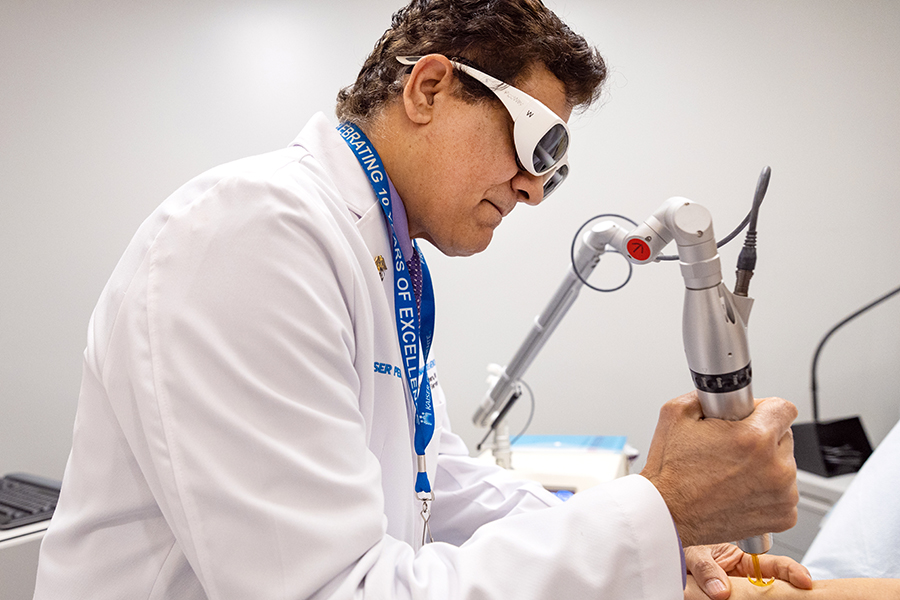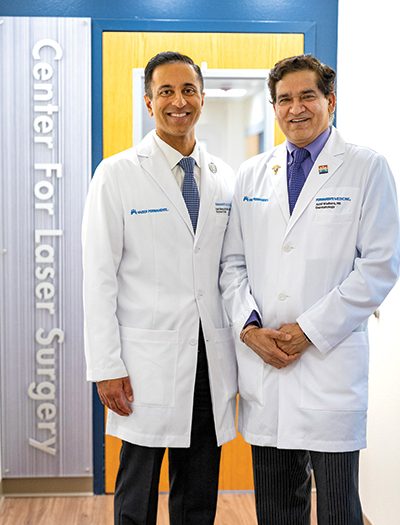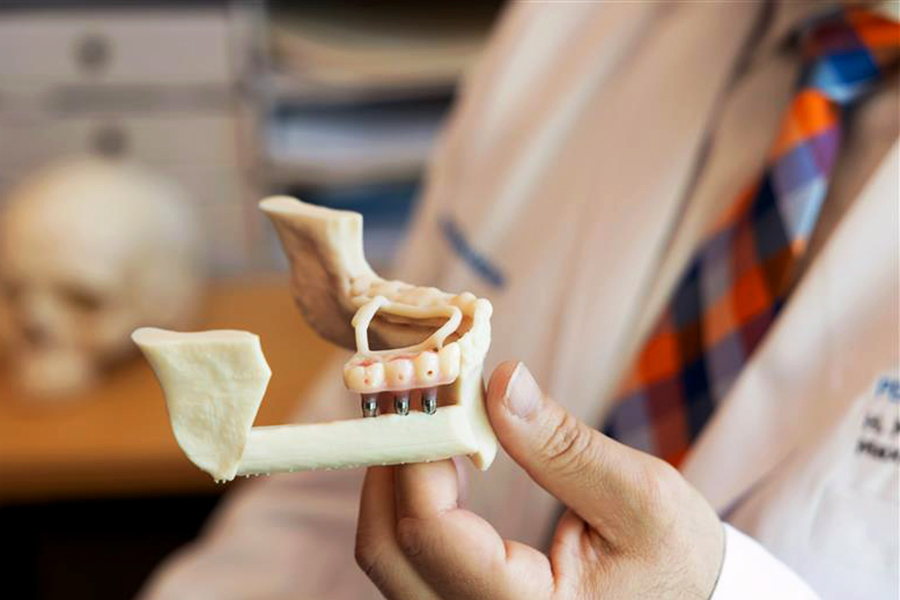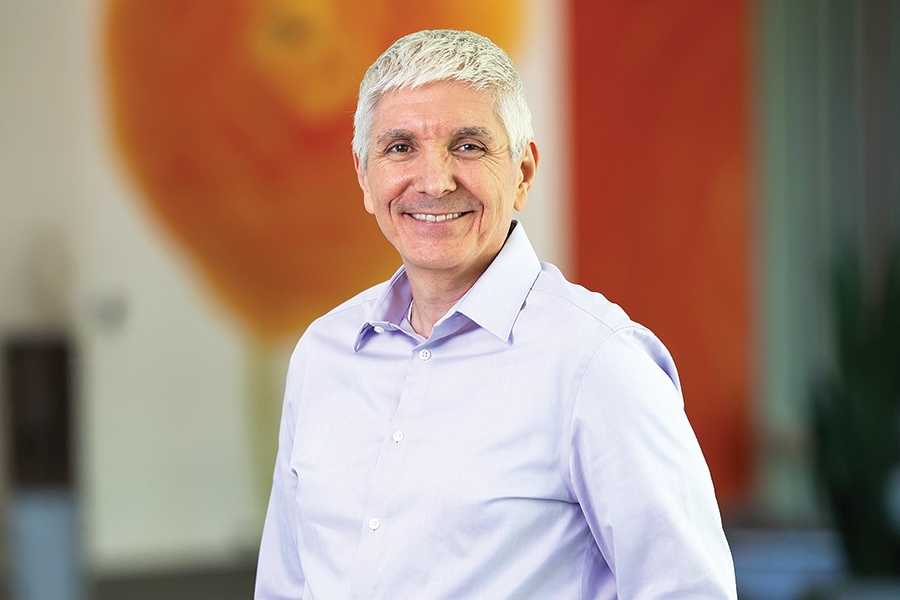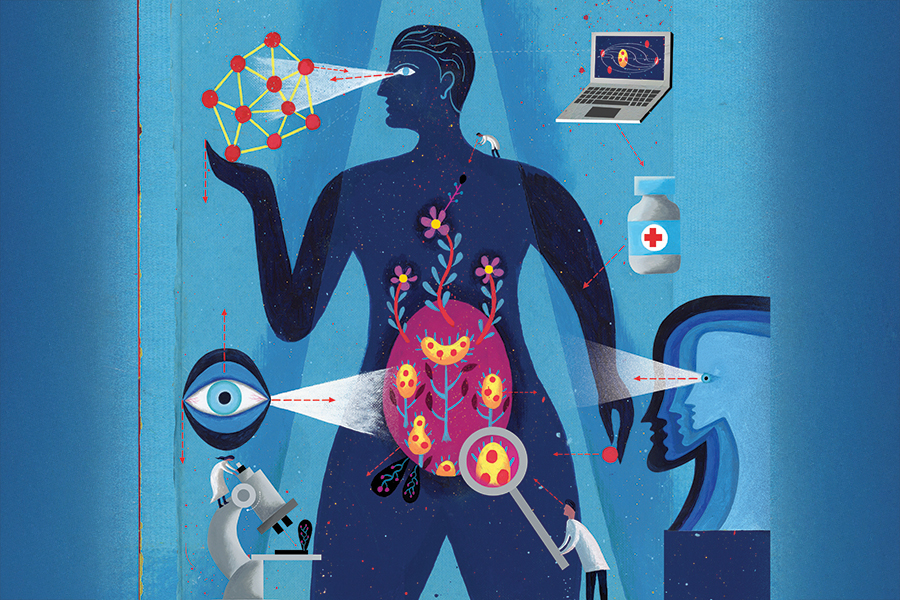The centers are transforming the lives of patients with disabling and disfiguring skin conditions in Kaiser Permanente Northern California.
December 20, 2024
If you ask dermatologist Akhil Wadhera, MD, about the patients he’s been able to help with the Laser Surgery program he pioneered in The Permanente Medical Group (TPMG), he likely will show you lots of before-and-after photographs of consenting patients, with a moving story about each one. But you can be certain he’ll begin with the patient who started it all — a woman who came into his office in 2011 with a rare, pigmented birthmark called nevus of Ota, which had caused the skin around her left eye to turn a dusky gray-blue color in her early teens. Although the condition typically presents at birth or in the first few years of life, it can also appear in puberty or during pregnancy, and is often mistaken for a bruise.
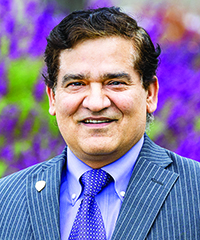
Akhil Wadhera, MD
“The common story for individuals with this birthmark — one that my clinical staff and I hear from tearful patients all the time — is that people assume they’re being abused,” says Dr. Wadhera, who practices at Kaiser Permanente Union City and Fremont. “This particular patient, who was 31 years old by the time she came to see me, had endured nearly two decades of questions and concern from well-meaning friends, teachers, neighbors, employers, and colleagues about parental and intimate partner violence. Some of these individuals had even called the police to her house to check on her.
“These experiences traumatized her and changed her way of interacting with the world,” Dr. Wadhera continues. “She never left the house without makeup, and she was constantly scanning to see where others were looking, ready to quickly move away from anyone who might ask intrusive questions.”
This patient had been under the impression since her teens in the 1990s that her condition was considered cosmetic, and that treatment would be an out-of-pocket expense. But in the summer of 1999, California’s state legislature enacted a reconstructive surgery statute, mandating health insurance coverage for surgery to correct or repair abnormal structures of the body caused by congenital defects, developmental abnormalities, trauma, infection, tumors, and disease, with the goal of restoring function or appearance, to the extent possible.
Bringing passion to light
Dr. Wadhera recognized that the patient’s condition fell under the reconstructive surgery statute and referred her for a series of laser treatments, which restored her skin color without any scarring and dramatically improved her quality of life. He then set out to make sure that every member in Kaiser Permanente Northern California who could be helped by laser technology under this statute would get the care they needed.
“My goal was to keep patients within our system for treatment, eliminate any confusion about medical versus cosmetic indications for laser surgery, and help make sure we don’t miss any opportunities to provide prompt, state-of-the-art care,” Dr. Wadhera says.
He delivered on this goal — and then some. Thanks to his dedication and the support of local and regional physician leaders, TPMG built a cutting-edge, regional program that has been providing evidence-based laser surgery to patients with medically indicated conditions for over a decade. Most recently, Dr. Wadhera spearheaded the construction of two dedicated Laser Surgery Centers, the only ones of their kind within Kaiser Permanente nationally. The primary center at Union City, which opened its doors in 2022, has 10 different types of lasers to treat more than 30 medically indicated conditions — from burn scars to vascular malformations — for patients across the region. The second laser center at Rancho Cordova opened last year to further increase access for patients with a debilitating skin disorder called hidradenitis suppurativa, for which Dr. Wadhera helped create a multidisciplinary program of its own.
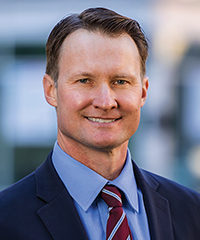
Brian Missett, MD
“I have an enormous amount of admiration for Dr. Wadhera, who is always looking for the next innovation to deliver better care,” says Brian Missett, MD, TPMG associate executive director. “It was not only his vision, but also his perseverance and commitment to our patients that enabled these programs to be stood up within TPMG. He’s a wonderful example of how we have a path in our organization for developing novel ideas and programs, and bringing our passions to light.”
Visions of an emerging leader
When Dr. Wadhera first proposed the development of a laser surgery program, he did so as a member of the inaugural cohort of the TPMG Emerging Leaders program. Physicians in this selective two-year program are nominated by their medical center’s physician-in-chief. In addition to attending residential sessions taught by business school faculty, participants work with their physician-in-chief to complete a change initiative over the program’s duration.
“At the time, we had an existing regional laser program at Kaiser Permanente Fremont exclusively for port wine stain birthmarks,” says Dr. Wadhera, adding that this program had been launched in the 1990s in compliance with the California reconstructive surgery statute. “Patients with most other types of laser-treatable conditions under this statute, however, were being referred outside Kaiser Permanente.”
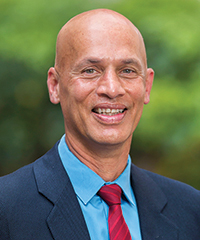
Sameer Awsare, MD
This led Dr. Wadhera to wonder, how many patients were being referred out for laser treatments each year? And what was the impact, both on patient experience and cost to the organization? He reached out to Sameer Awsare, MD, TPMG associate executive director who oversees outside referrals, to collect some data. Then, as part of the Emerging Leaders program, Dr. Wadhera gave a presentation to the chiefs of dermatology in 2012, sharing the story of his patient with nevus of Ota, his vision to expand the Port Wine Stain program into a regional Laser Surgery program, and the data to support the need for such a service.
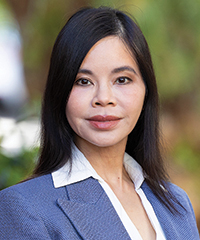
Ngoc Pham, MD
TPMG Chair of Dermatology Ngoc Pham, MD, one of the chiefs in the room at the time, describes the response as unanimously supportive — “without any reservations.”
“We all were moved by Dr. Wadhera’s passion and immediately saw the value for patients and the organization,” says Dr. Pham, who practices at Kaiser Permanente Santa Clara and has served as chair since 2014. “This program would fill clinical and service gaps, as well as a subspecialty niche within dermatology. When you bring in the armamentarium of a laser service, you are augmenting the potential breadth of therapies available to a patient with any particular skin condition.”
Birth of a new service
The program was launched a few months later, with the enthusiastic support of executive and local leadership. Dr. Wadhera worked to establish a subspecialty referral pathway within eConsult for dermatologic laser surgery, and then delivered trainings to educate dermatologists and primary care physicians about the new pathway and appropriate referrals.
Over the next three years, he worked with Dr. Missett to acquire the different types of lasers needed, which were initially housed in the medical and cosmetic dermatology spaces in the Greater Southern Alameda service area. But by 2019, regional demand for the laser surgery service was outpacing space and staffing, especially for patients with hidradenitis suppurativa (HS), for whom laser hair removal can be a lifechanging treatment.
“To better support the HS patient population, and all our patients treated in the laser surgery program, I created a proposal to build dedicated laser centers,” says Dr. Wadhera. (Read “Rays of Hope” at the bottom of this article to learn more about how HS was key in bringing Dr. Wadhera’s vision for regional laser centers to fruition.)
With the support of TPMG executive leaders, including Drs. Missett and Awsare, as well as partnership from Kaiser Foundation Health Plan and Hospitals, he was successful. The Laser Surgery Center at Union City opened its doors two years ago. Dr. Wadhera spends half of his clinic time treating patients there, with the support of several registered nurses, physician assistants, and medical assistants. A second center at Rancho Cordova, which opened a year later with similar staffing, focuses exclusively on patients with HS.
Individualized care by the thousands
![]() In 2022 and 2023 alone, the Laser Surgery Center at Union City delivered more than 4,300 treatments for a variety of medically indicated dermatologic conditions, including birthmarks, vascular malformations, trauma scars, and certain skin conditions. (For a full list, see “What’s Treated at the Laser Center” at left.)
In 2022 and 2023 alone, the Laser Surgery Center at Union City delivered more than 4,300 treatments for a variety of medically indicated dermatologic conditions, including birthmarks, vascular malformations, trauma scars, and certain skin conditions. (For a full list, see “What’s Treated at the Laser Center” at left.)
“The excellent care we provide to so many patients would not be possible without my amazing team,” says Dr. Wadhera. “Our nurses Michelle Menezes and Dorothy Laine, and my medical assistant Elizabeth Paradela, have been on this journey with me from the beginning.”
A question Dr. Wadhera receives often is how lasers are able to treat so many different kinds of skin problems. His answer is simple: “the amazing selectivity of laser light.”
For indications such as birthmarks and hair removal, he explains, he uses lasers that target chromophores, which are the molecules in tissue that absorb specific wavelengths of light and reflect visible color.
“We can also titrate the intensity and depth of the laser, so we can treat a problematic area without damaging the overlying normal skin or intervening tissues,” says Dr. Wadhera. “For a vascular lesion like a port wine stain or venous malformation, for example, we can target the red or purple chromophores in the blood vessels that are located several millimeters below the skin.”
For hair removal — such as from a skin graft that had previously been placed inside a patient’s mouth or on the palm — he uses a laser whose target chromophore is melanin.
To treat patients with scarring from severe burns or trauma, who often have restricted movement, Dr. Wadhera uses a different type of laser that works by poking tiny holes in the scarred skin. “The procedure can immediately increase mobility, and as the skin heals, it repairs itself with a different, less restrictive subtype of collagen,” he says.
As an example, he shows a “before” photograph of a patient who couldn’t lift her left arm past her shoulder because her burn scars were so severe. In the photo taken right after the laser procedure, she can extend her arm straight up and bend her elbow across her head.
“To treat this same patient surgically, you would have to take a graft or tissue flap from elsewhere on her body, and then remove the scarred skin from her left arm and place the graft or flap,” Dr. Wadhera explains. “She would then have to do physical therapy and wear a compression garment for several months to years, after which she may see a similar level of improvement in mobility.”
Restoring patients’ self-confidence
Another subset of patients treated at the center have disfiguring or disabling benign tumors, which may be limited to a single growth, or cover large areas of skin on the face, scalp, and body. For many of these patients, Dr. Wadhera uses an erbium or CO2 laser that targets water as a chromophore in the tissue.
“When I fire the laser, it evaporates skin,” he explains. “I keep firing until I get a smooth surface or reach the desired depth.”
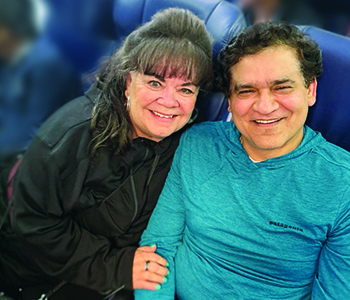
Dr. Wadhera (right) and patient Linda Emanuele crossed paths on an airplane two years after he treated her for a disfiguring growth on her nose. “To me, he’s more than a doctor, he’s a miracle worker,” she says. “He gave me my life back.”
For patient Linda Emanuele, this ablative treatment had a huge impact on her quality of life. She came to see Dr. Wadhera in 2022 for a trichoepithelioma, a type of tumor that originates from hair follicles and has a rare risk of malignant transformation. (For patients with certain genetic syndromes, these growths
can cover the entire face.) Ms. Emanuele’s grape-sized tumor was located on the side of her nose, pressing against her nostril. Although it was not yet impeding her breathing, it soon would be.
“My bump, as I called it, was getting larger and larger,” she says. “I tried not to let it get in my way of living a full life, but it affected my self-confidence, and I started avoiding going to social events. I did my best to cover it with masks and large sunglasses — I didn’t want anyone to ask me about it. I delayed going to the doctor for a long time.”
After a biopsy to confirm diagnosis, Dr. Wadhera completed the series of treatments that effectively erased the tumor that Ms. Emanuele had lived with for 20 years. Then in an odd twist of fate, she ran into him on an airplane two years later.
“I was the last passenger to get on a connecting flight on my way home from North Carolina, so I took an open middle seat up front,” Ms. Emanuele said. “After I sat down, the gentleman next to me put his hand on my shoulder and said, ‘Well, Linda, how are you doing?’ I realized, it’s Dr. Wadhera! I was overjoyed to see him — I was hugging him, thanking him — the flight attendant even came over to see what all the fuss was about.
“To me, he’s more than a doctor, he’s a miracle worker. He gave me my life back. I don’t have to hide anymore.”
Making waves into the future
Dr. Wadhera has given presentations at many national dermatologic society meetings, both on the impact of the TPMG Laser Surgery program in general, and on specific cases. One of these will soon be published: a novel case study of a young man whose allergic reaction to the blue ink in his tattoos was causing him to go blind.
“This patient had developed bilateral uveitis and iritis, ocular hypertension, and glaucoma about six months after getting the tattoo,” Dr. Wadhera says, adding that this is an extremely rare late sequela of tattooing, caused by an inflammatory response to certain inks. “The patient had failed the recommended systemic steroid and immunosuppressive treatments, so his TPMG ophthalmologist called me to see if I could help.”
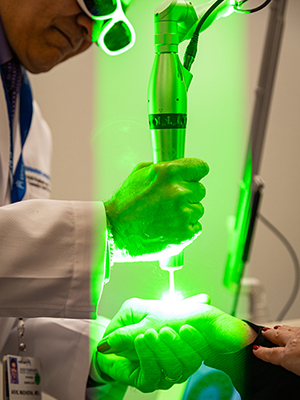
Dr. Wadhera using a laser to treat a patient.
Dr. Wadhera treated the patient with four ablative CO2 laser treatments — stronger than the type of laser typically used to remove tattoos — and specifically targeted the blue ink. The results were unmistakable: The patient’s eye symptoms improved significantly, his vision stabilized, and he got off all immunosuppressive medications. Dr. Wadhera hopes this case study will serve to help others in the future.
In addition to sharing his expertise with colleagues and the broader field of dermatology, Dr. Wadhera teaches medical students and residents from Drexel University, Stanford University, and the University of California, Davis. He also has begun consulting with other Kaiser Permanente regions, including Southern California and Northwest, who are interested in launching laser services of their own. And as the program continues to grow in Kaiser Permanente Northern California, he has plans to add a third laser center in another service area.
When asked if he has any takeaways from all that he’s accomplished, Dr. Wadhera points to the integrated, physician-led organization that made it all possible.
“The Permanente Medical Group is a great place to practice medicine,” he says. “When I joined the medical group, I didn’t know I would be doing any of this work. I just saw an opportunity to improve care and said, how can I help with this? And what I found was supportive physician leadership and colleagues, and a system designed to help me be successful. It was a breath of fresh air.
“My hope is to inspire other people to do similar things in their field of expertise. So I would say to my colleagues, if you have the skill set and passion, say something and do something. It’s possible here.”
This article originally appeared in Permanente Excellence, the magazine for physicians in The Permanente Medical Group.


